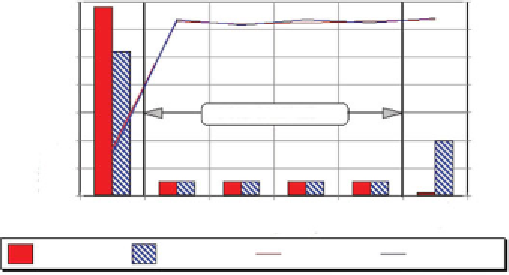Environmental Engineering Reference
In-Depth Information
material, a potentially inexpensive source of calcium for
cement production. The fresh N-viro soil gives out ammo-
nia (NH
3
(g)) as a by-product of the process, which needs to
be mitigated prior to handling the material. Electrokinetic
extraction was proposed to reduce the excess ammonia in
N-Viro Soil™. The visual and textural observation of the
granular material indicated fine sand to silt size mixture
with little plasticity. The leachate was a brown colored liq-
uid. Upon arrival, the leachate was acidified to arrest NH
4
+
in the liquid, thereby preserving its original concentration.
The test specimens were prepared by mixing the N-Viro soil
with the leachate at the reported liquid content of 65%. Two
tests were conducted at constant potential of 30 V applied
across the electrodes for the 200-hr duration of treatment
for each. The voltage gradient measured in the samples
remained at approximately 0.3 V/cm. At the termination of
each test, the soil was sampled at three points along its length
and analyzed for moisture content, pH and NH
4
+
concentra-
tion distribution. Figure 2.17 shows the post-electrokinetic
distribution of the measured concentration of NH
4
+
and the
pH along the soil sample and the anode and cathode liquid
chambers. Overall, the concentration of ammonia in the soil
samples were reduced from about 150 mg/kg to less than 6
mg/kg in both samples tested.
The mass balance determination showed that for more
than 50% of the ammonia was unaccounted. Larger
70
60
50
40
30
20
10
0
14
12
10
8
SOIL SAMPLE
6
4
2
0
Anode
water
0.25
0.50
Section along sample
0.75
1.00
Cathode
water
Sample EK1
Sample EK2
pH-EK1
pH-EK2
Figure 2.17
Post Electrokinetic Distribution of NH
4
in Processed Municipal Sludge Soil
(Pamukcu and Huang, 2001)
















Search WWH ::

Custom Search